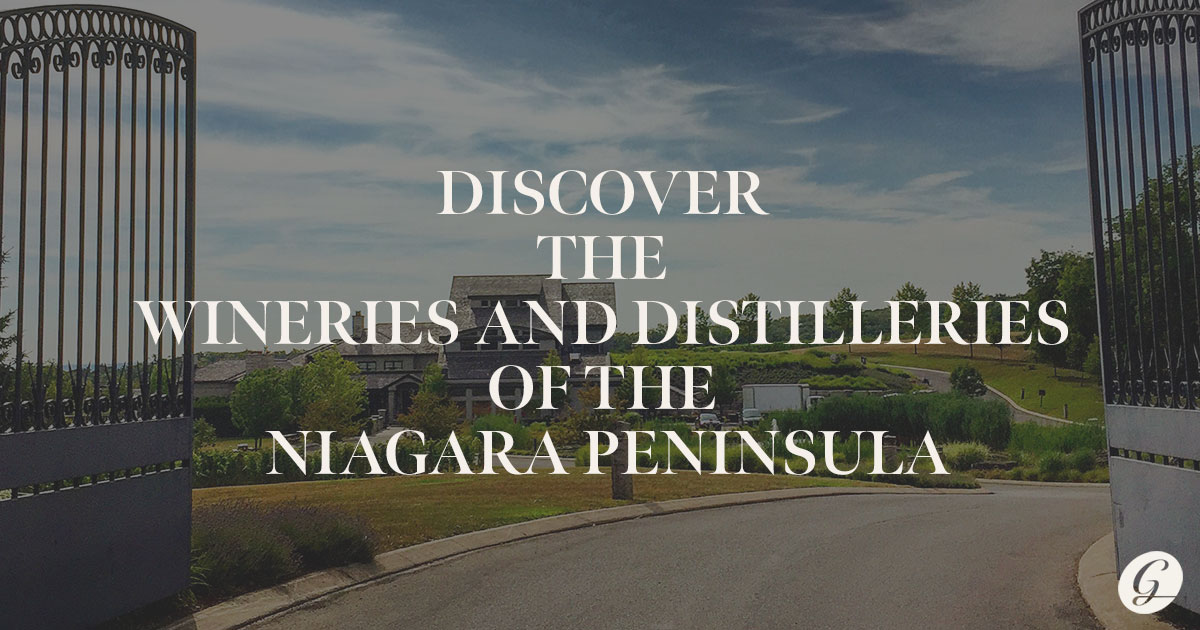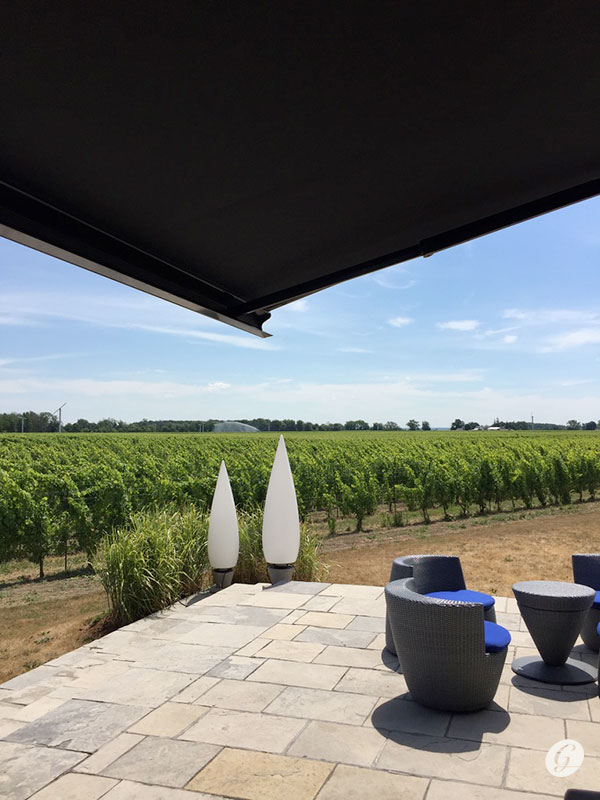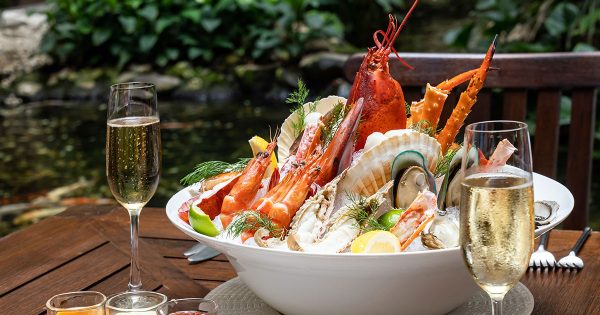Discover the wineries and distilleries of the Niagara Peninsula

While we have articles, which you can see below, about our visits to wineries and distilleries of the Niagara Peninsula, we needed an article to list them. Here it is at last. We’ll also try to tell you the best practices for your visits.
What is the Niagara Peninsula?
The Niagara Valley isn’t Niagara Falls, although they’re not far away. What’s known as the Niagara Peninsula (for wines, but there are distilleries too) has the largest planted area of any wine region in Canada.
Located at around 43° north latitude (about the same as the Bordeaux region of France), this first-rate and diverse appellation is characterized by rich, fertile soils and unique mesoclimates. These conditions are ideal for producing wine grapes of greater complexity and flavour than in many warmer climates. The most common grape varieties are Chardonnay, Cabernet Franc, Riesling, Sauvignon Blanc, Cabernet Sauvignon and Merlot.
In 2023–2024, production (9-liter cases) was exactly 1,033,051 cases for 1,364 appellation wines. Classic cool-climate varieties such as Riesling, Chardonnay, Gamay Noir, Pinot Noir and Cabernet Franc flourish here. With an impressive array of over 46 thriving vineyard types spanning across 13,600 hectares, this region boasts remarkable diversity. Among them are various fruit crops, including renowned peaches and blueberries. The Niagara Peninsula continues to shape Canada’s growing quality wine industry, home to approximately 55% of Ontario’s VQA wineries.
Characteristics of the region

Pinot Noir at Hidden Bench Estate Winery
Photo : Normand Boulanger | Gentologie
Topography
Bordered by Lake Ontario to the north, the Niagara River to the east and the Welland and Hamilton Rivers to the south and west, the Niagara Peninsula is Canada’s largest and most diverse wine-growing region. The Niagara Peninsula can be divided into three main physiographic zones: the Lake Iroquois Plain, the Niagara Escarpment and the Haldimand Clay Plain.
The Niagara Escarpment, some 177 metres above sea level, runs directly through the appellation. This north-facing cliff formation is the very essence of the appellation, providing the slopes (which determine sunshine) and elevations (which determine the influence of breezes and lakes) that distinguish unique sub-appellations and a diverse range of wine-growing conditions.
The Soil
Over the past 200,000 years, the Niagara Peninsula has experienced several glacial and interglacial episodes that have eroded and shaped the sedimentary rock layers and ancient reef structures of the Niagara Escarpment, resulting in complex soil compositions in the area between the escarpment and Lake Ontario, where thick layers of clay are impregnated with silts and sands. The variation in soil composition and drainage across the appellation allows many different grape varieties to thrive, while producing distinct sub-appellation terroirs that bring their own character to the development of the roots and, in turn, the development of the vines and grapes.
The Climate
The Niagara Peninsula is a cool-climate appellation, ideally located near the 43rd parallel, with relatively high day-night temperature differentials and plenty of sunshine during the growing season. This combination allows more complex and intense grape aromas to develop during ripening than in warmer climates.
The constant circulation of coastal breezes between Lake Ontario and the Niagara Escarpment profoundly moderates seasonal temperatures throughout the appellation. In autumn, breezes from summer-warmed lake waters raise land temperatures and prevent cold air from settling in low-lying areas, extending the growing season into autumn.
In spring, breezes from the winter-cooled lake slow down spring warming, delaying the development of fruit buds until the danger of late spring frosts has passed, and ensuring a balanced start to the season. These lake effects vary considerably depending on distance from the lake shore and topography, giving rise to remarkable differences in flavour between grapes from sub-appellations located on the lake shore and those from inland.
The regional appellations

Map of Niagara Peninsula Appellations
Photo: VQA Ontario
There are 3 regional appellations:
- Niagara Escapement
- Niagara-on-the-Lake
- Niagara West
And for the sub-appellations there are :
- Beamsville Bench
- Creek Shores
- Four Mile Creek
- Lincoln Lakeshore
- Niagara Lakeshore
- Niagara River
- Short Hills Bank
- St. David’s Bank
- Twenty Mile Bank
- Vinemont Ridge
Planning your visit to the wineries and distilleries of the Niagara Peninsula

The entrance at Southbrook Vineyards
Photo: Normand Boulanger | Gentologie
Located 90 minutes/130 kilometres from Toronto, the Niagara region (which includes the vineyards and distilleries of the Niagara Peninsula) stretches for around 80 kilometres. It’s best to plan your itinerary carefully, as the vineyards are sometimes several kilometres apart. And the traffic, the number of roads and the condition of the roads (you’re in the countryside here) aren’t always what you want.
Plan your appointments and visits accordingly, and try to schedule them in the same area, as much as possible. This will minimize the number of times you need to travel between the wineries and distilleries of the Niagara Peninsula. And don’t hesitate to contact the wineries and distilleries you’d like to pay a visit to plan your visit better. And don’t forget to book your tastings when you visit the wineries and distilleries of the Niagara Peninsula.
Where to stay during your visit to the wineries and distilleries of the Niagara Peninsula
When visiting the wineries and distilleries of the Niagara Peninsula, you’ll want to stay in the area, not in Toronto. There are several hotels in Niagara Falls, but that may not be the spirit you want to be in when visiting wineries. Some wineries offer accommodation, but remember to book several weeks or less in advance.
There are also a few Airbnbs, but they are rarer and change frequently. Niagara’s Finest and Vintage Hotels are highly recommended for your visit to the wineries and distilleries of the Niagara Peninsula.
Where to eat on your visit to the wineries and distilleries of the Niagara Peninsula
There’s no shortage of restaurants in the region. In fact, at the time of writing, the Restaurant at Pearl Morissette has just won the title of best restaurant in Canada according to Canada’s 100 Best. It had not yet been built when we visited the estate. The restaurant at Redstone is interesting, though more classic in form and a little less upmarket. Many of the wineries have kitchens or events, so try to drop in when you can to enhance your stay as you visit the wineries and distilleries of the Niagara Peninsula. The best way to find out about these various events is again and again via social networks.
Discover our different articles on our visits to the different wineries and distilleries of the Niagara Peninsula

View of the vineyard at Stratus Vineyards
Photo: Normand Boulanger | Gentologie
- Stratus Vineyards
- Domaine Pearl Morissette
- Vignoble Hidden Bench Estate Winery
- Tawse Winery
- Redstone Winery
- Southbrook Vineyards
- Rosewood Estates Winery
- Dillon’s Small Batch Distillers
Enjoy discovering the wineries and distilleries of the Niagara Peninsula




